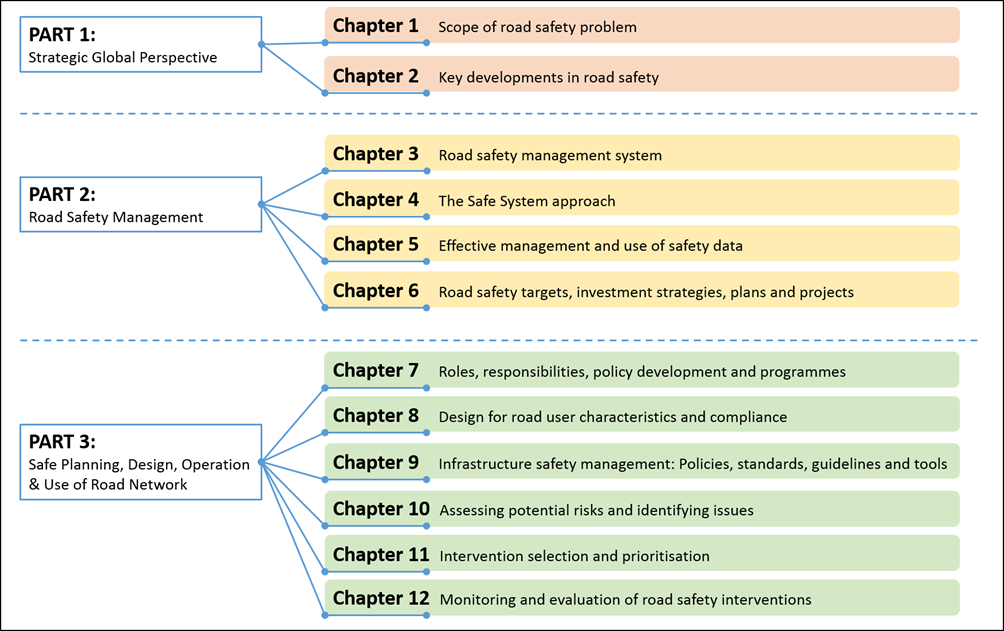
Road Safety Manual
A manual for practitioners and decision makers
on implementing safe system infrastructure!

Road Safety Manual
A manual for practitioners and decision makers
on implementing safe system infrastructure!
Road crashes account for an estimated 1.19 million deaths and up to 50 million injuries worldwide each year with over 90% of the deaths occurring in low and middle-income countries (LMICs) (The World Health Group - The High Toll of Traffic Injuries: Unacceptable and Preventable).
Recognition of this problem has led to the UN Second Decade of Action in Road Safety (2021–2030) which has the ambitious goal of stabilizing and then reducing the forecast levels of global fatalities. This Road Safety Manual is a key contribution to the UN Decade of Action by the World Road Association.
One of the major global requirements is to improve road safety performance through capacity building across the road safety management system. A range of guides to road safety interventions and management has been produced in recent years but further guidance on specific elements is needed, particularly in the areas of the safe planning, design, operation and use of the road network. Such a task requires understanding and consideration of the road safety management needs of low, middle and high-income countries as well as accurate, comprehensive and easily accessible technical information.
In addition, international organisations identify the Safe System as a best practice approach to managing road safety for both the long-term and the interim, and promote its take-up by all countries. The Safe System approach builds on the best of previous approaches and promotes innovation and the adoption of technologies that are based on well-established safety principles.
The next steps in road safety present challenges for road safety managers and professionals all over the world. This manual sets out ways in which road safety policy makers and practitioners in low, middle and high-income countries can establish, strengthen and consolidate their efforts to address the challenges before them.
The manual is designed to be a comprehensive, state-of-the-art international reference document and a ‘living’ tool that can assist all countries in fulfilling key objectives. The focus is on guiding the management of the safe planning, design, operation and use of the road network in low, middle and high-income countries. The manual highlights effective management and policy frameworks, technical references and provides overall guidance on the management of interventions to achieve results.
The Road Safety Manual (RSM) is a product of the World Road Association (PIARC) which was published in 2003 to align it with Decade of Action objectives and the Safe System approach to managing safety. It brings together PIARC’s own guidance and that produced by other international organisations. This version (2019) is based on the first publication in 2003 and the update in 2015. The goal of the 2019 update is not to rewrite the manual, but to add new information, best practice and new case studies.
Organisation and scope of the manual
The manual is organized into the following three Parts.
This part provides a strategic global perspective of the scope of the road safety problem and key developments influencing current approaches to managing for results which underpin this guidance:
This part provides guidance on road safety management. It presents the foundation for delivering targeted improvements using results-focused strategies, programmes and projects:
This part provides detailed guidance for road planners, policy makers, engineers and other practitioners on the management of intervention for the safe planning, design, operation and use of the road network:
The different parts of the manual are shown in the figure below:

This Road Safety Manual was updated by the Technical Committee C.1 National Road Safety Policies & Programs (2016-2019), Working Group 1 with Working Group 2 support.
The contributors to the Road Safety Manual update are presented below in alphabetical order:
The primary authors and editors of the Road Safety Manual 2023 update are:
Committee C.3.1 Road Safety (2020-2023) chairman and secretariat are:
The case studies were provided by participants that are not necessarily part of the PIARC organization. Their names are mentioned at the end of each case study, typically being the “Contact names”. This catalogue could not be realized without their contribution and the authors of this report acknowledge their valuable participation.